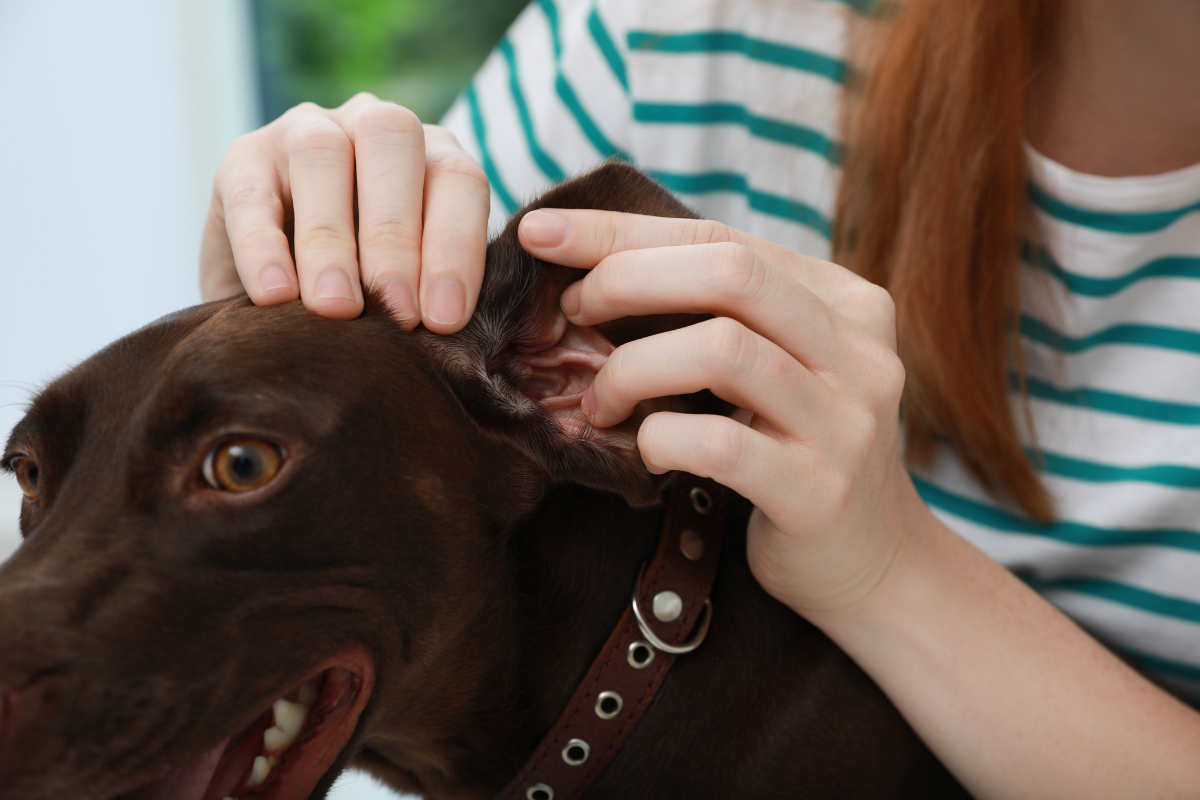Tick-Free Tails: Securing Our Dogs from Ticks Menace
Understanding Ticks and Their Risks
Man, those pesky ticks! They’re always looking to hitch a ride on our pets, especially when the weather’s warm and they’re out in full force. Let’s dive into how we can keep our dogs safe from these bloodsuckers.
Impact of Flea and Tick Season
When flea and tick season kicks in, it’s like a grand buffet for ticks, and our dogs are on the menu! These little critters can cause all sorts of issues once they snag a spot on our pups. They’re not just freeloaders—they’re troublemakers, too, causing skin drama and even more serious stuff like Lyme disease. Once ticks have clamped down and started dining on our pets’ blood, the problems begin to snowball (American Kennel Club).
| Problem | What’s Happening Here |
|---|---|
| Skin Infections | Think redness and itchiness at the bite site |
| Lyme Disease | Could lead to limping, joint pain, fever, and if left unchecked, even scarier stuff like kidney and heart issues |
| Transmission to Humans | Yep, diseases like Lyme disease and Rocky Mountain spotted fever don’t just stick to pets—they can jump to us humans too (Pets & Parasites) |
It’s smart to batten down the hatches with some prevention tactics during flea and tick season to steer clear of these bloodsuckers.
Common Tick-Transmitted Diseases
Ticks may be teeny, but they pack a punch when it comes to spreading diseases to our dogs. Here’s the lowdown on the nastiest tick-borne illnesses your pup could face.
| Disease | Tick Culprit | Symptoms in Dogs | Risk Level |
|---|---|---|---|
| Lyme Disease | Black-legged tick (deer tick) | Limping, joint pain, fever, major concerns like kidney trouble, heart issues, and neurological messes (Westport Veterinary Associates) | High |
| Canine Anaplasmosis | Deer tick | Sluggishness, fever, stiff joints, no appetite, stomach issues, even seizures (Westport Veterinary Associates) | Medium |
| Rocky Mountain Spotted Fever | American dog tick, Rocky Mountain wood tick, brown dog tick | Fever, sluggishness, muscle aches, lack of appetite, occasionally mental confusion | High |
Ticks latch onto your dog and start sipping their blood like they’re at an open bar, which in some cases can lead to anemia if enough blood is lost. Regular tick checks and being on the ball about potential hazards make a world of difference in keeping our best friends healthy. For the full scoop on what could make your pup sick and what symptoms to watch out for, swing by our dog diseases and symptoms section.
By staying on top of it and keeping our eyes peeled, we’re laying the groundwork for our dogs to stay all waggy-tailed and happy. Check out our guides on why regular tick checks matter and top tick control products for more tips on keeping these nasties away.
Prevention and Treatment Tips
Let’s keep our dogs tick-free and bouncing with joy! These tiny pests can cause big problems, so we need to be on top of our game with prevention and treatment. We’re diving into advice from vets, tick-busting products, and why it’s a good idea to give your pup a regular once-over.
Veterinary Recommendations
Our vets are like the superheroes of the pet world, always ready to help us tackle tick troubles. They suggest using tick control products regularly (Pets and Parasites). Most tick-related issues can be handled with their magic touch, but keeping an eye on our furry friends after they’ve been in tick territory is crucial. This means regular checks and lab tests (AKC Canine Health Foundation). If a dog catches a tick-borne bug, continuous check-ups might be needed.
Tick Control Products
To keep ticks at bay, we have several weapons in our arsenal like spot-on treatments, oral pills, collars, and even tick-specific shampoos. Each one has its perks and special instructions.
| Product Type | What It Does |
|---|---|
| Spot-On Treatments | Easy to apply directly on your dog’s skin. They last a long time! |
| Oral Medications | Given by mouth. They work fast to kill ticks before they hitch on. |
| Tick Collars | Fits around the neck. Keeps your dog shielded for months. |
| Tick Shampoos | Use during bath time. Kicks ticks out right away. |
Your vet can help pick the best tick fighter for your dog’s lifestyle. You gotta stick to the instructions for these products to make ’em work right and keep your buddy safe.
Importance of Regular Checks
It’s a good habit to check our pups for ticks, especially after a romp in the outdoors. Walks, hikes, or just a romp in the yard can all end with a tick surprise! Catch those ticks early and avoid the spread of diseases.
Be sure to investigate these spots on your dog:
- Ears
- Neck
- Underbelly
- Between toes
- Groin area
- Base of the tail
Regular checks are like a safety net against diseases like Lyme disease and others (black ticks on dogs). Check out our guide for detailed safe tick removal techniques.
By following these tips, we can keep our four-legged pals safe from ticks and ensure they’re as happy and healthy as possible. Stay vigilant with tick checks, use the right control products, and lean on your vet’s expertise to keep ticks from crashing the party!
Tick-Borne Diseases in Dogs
Ticks. Yeah, those little bloodsuckers can really mess with our pups. Knowing the dangers they bring can arm us with the know-how to shield our canine companions. Let’s get into some common tick-borne diseases that every dog owner should have on their radar.
Anemia and Paralysis Risks
Ticks have been known to cause anemia in dogs because they guzzle up a lot of blood—although it’s not every day you see this, it’s something to keep in mind. Then there’s this freaky bit: some lady ticks can spit out a toxin that causes paralysis in dogs while they chow down. Scary stuff, so get your furry friend to the vet ASAP if you spot anything off.
Lyme Disease Symptoms
Lyme disease isn’t just a humans-only gig — it’s pretty infamous among dogs too. Carried by the deer tick, it can bring fever, lameness, swollen joints, a lack of enthusiasm for food, and lethargy. If it gets out of hand, it can mess with the kidneys, heart, and nervous system. For the full scoop, don’t miss our dog diseases and symptoms page.
| Symptom | Lyme Disease Hit Rate |
|---|---|
| Fever | High |
| Lameness | Common |
| Joint Swelling | Common |
| Loss of Appetite | Common |
| Lethargy | Common |
Bartonellosis and Canine Anaplasmosis
Canine Bartonellosis
Our friend, the brown dog tick, passes this one along. It can make your pooch feverish, lame in the leg department, confuse its noggin, trigger seizures, put them off their feed, or make their heart do the cha-cha. And heads-up: humans aren’t safe from it either, so make sure you’re preventing tick encounters for both ends of the leash.
Canine Anaplasmosis
Dog tick fever. Doesn’t sound fun, does it? Delivered by the deer tick, it might bring fever, tiredness, stiff joints, no appetite, diarrhea, and even hurling. Seizures could be on the menu if things get serious. Dog folks, if you notice any of these signs, hustle your buddy to the vet pronto.
Want to be the hero your dog thinks you are? Stay a step ahead with our guide on dog health to outsmart those pesky ticks.
Those ticks aren’t playing nice — they pose real risks to our pups. But knowing the facts means we can take action. Regular checks and preventive steps can keep our four-legged pals wagging their tails in good health. For more tips on handling dog health woes, pop over to our dog diseases and symptoms page.
Get wise about these nasty diseases and their signs. By doing that, we become the tick-busters our dogs need, protecting them from harm and giving us more time for belly rubs and fetch.
Transmission to Humans
Ticks aren’t just creepy crawlies threatening our dogs—they’re after us too! Understanding these diseases and how to avoid them means keeping both our pets and ourselves in the safe zone.
Lyme Disease in Humans
Lyme disease, which sounds nicer than it is, comes courtesy of a sneaky little bacterium called Borrelia burgdorferi. Bugger hitchhikes on black-legged ticks (aka deer ticks) and finds its way under our skin. A tick bite can send symptoms like fever, headaches, fatigue, and a rash that looks like you’ve been the dartboard in a game of arrows—showing up anytime from three days to a month later.
Ignoring it isn’t a wise choice. Left untreated, Lyme can really mess up things—joint pain, heart palpitations, and brain-fog are just the start. We need to channel our inner detective after we’ve been outside, checking for ticks pronto. Yank those suckers out ASAP to seriously cut the risk (American Kennel Club).
| Symptoms | Show Up When? |
|---|---|
| Fever | 3 days – 1 month later |
| Headache | 3 days – 1 month later |
| Fatigue | 3 days – 1 month later |
| Bull’s-eye Rash | 3 days – 1 month later |
For how our doggos might react, here’s the scoop on ticks in dogs.
Rocky Mountain Spotted Fever
Rocky Mountain spotted fever (RMSF) isn’t a walk in the park, for us or Fido. The American dog tick, Rocky Mountain wood tick, and brown dog tick are the troublemakers here. They’re small but mighty dangerous without quick antibiotic action.
Symptoms make a nuisance appearance a week or two after a bite—feeling feverish, headachey, tummy aches, and muscle pains. Then comes the blotchy rash, taking a grand tour from wrists and ankles across your body.
Quick doc visits and antibiotics can keep us out of serious trouble. Regular tick-checks and swift removal are MVP moves (American Kennel Club).
Preventative Measures for Both
Staying off a tick’s dinner plate is the name of the game for us and our pooches. Here’s your playbook:
- Thorough Checks: Give yourself and furry pals a post-outdoors check. Be extra cautious around the scalp, ears, and underarms.
- Tick-Guarding Products: Deck your dogs out with tick-fighting gear—collars, topicals, or chewable meds. Here’s more on tick control products.
- Smart Dressing: Wear long sleeves, pants, and closed shoes on hikes. Light clothes are your secret weapon to spotting ticks fast.
- Yard Cleanliness: Keep your yard prim and proper—mow the lawn and clear away leaves and tall grasses to give ticks fewer hideouts.
- Vet Visits: Keep those vet appointments regular—they’re key in spot-checking for tick troubles and other dog diseases.
These steps will help keep our four-legged buddies and ourselves safe from these tiny terrors. Stay clued-in and proactive for a tick-less life! Dive deeper into doggy dilemma solutions in our section on dogs and ticks and similar topics.
Tick-Borne Diseases Details
Oh, those pesky little ticks really know how to cause a ruckus! They can bring some nasty surprises to our four-legged pals. So, if you love your pooch as much as we do, it’s good to be in the know about these tick-borne nuisances and how to keep your furry buddy safe. Here’s a rundown of a few of the diseases ticks love to share with our doggos.
Canine Ehrlichiosis
Ever hear of Canine Ehrlichiosis? It’s not something you’ll want your pup coming down with. Think sneaky bacteria from Ehrlichia, passed on by those cheeky brown dog and lone star ticks. Trust us, they bring the party with fevers, bruising, random nosebleeds, zero interest in dinner, and even low blood platelets (Westport Veterinary Associates).
| Symptom | What’s Going On |
|---|---|
| Fever | Doggie’s heating up! |
| Bruising | Skin’s got those odd colors from blood leaking out |
| Nosebleeds | The snout’s bleeding, yikes! |
| Poor Appetite | Fido’s not interested in his kibble |
| Low Blood Platelets | Trouble with clotting up that blood |
Wanna know more about dodging these nasties? Check out our dog diseases page.
Protozoal Diseases Overview
Now, let’s chat about Protozoal diseases like Canine Babesiosis and Canine Hepatozoonosis.
- Canine Babesiosis: This bad boy’s all about the Babesia parasite, hitching a ride via ticks. These parasites sometimes even sneak from mama to pups. Symptoms? Jaundice, dark pee, lethargy, barfing sessions, and a weak Fido (Westport Veterinary Associates).
| Symptom | What’s Happening |
|---|---|
| Jaundice | Skin and eyes got that yellow hue |
| Dark-Colored Urine | Pee’s looking darker than usual |
| Lethargy | Dog’s acting like it’s been up all night |
| Vomiting | Upchuck alert! |
| Weakness | Pooch seems less superhero, more sleepyhead |
Need more scoop? Hop on over to our dog diseases and symptoms articles.
Canine Hepatozoonosis
Next on the list is Canine Hepatozoonosis, a gnarly disease from ingesting infected critters. Yeah, rats and their ilk are no good! Symptoms mimic those from Canine Babesiosis, stressing the need for fast action and prevention (Westport Veterinary Associates).
Stay vigilant with your tick protocols to keep your pup in tip-top shape. We’ve got more on spotting tick troubles in our symptoms of ticks in dogs guides.
By arming ourselves with the facts about these tick-borne nasties, we can keep our tail-wagging buddies safe and sound from these creepy crawlers.
Removal and Care
Safe Tick Removal Techniques
Getting ticks off our pups is crucial to dodge those pesky tick-borne ailments. Best bet? Use some fine-tipped tweezers. You want to grab that little critter as close to your dog’s skin as you can, then slowly pull it straight out. No twisting or turning; this way, there’s less chance of leaving bits of the tick behind.
| What You Need | What to Do |
|---|---|
| Fine-point tweezers | 1. Pinch the tick near the skin 2. Slowly pull upwards 3. Make sure it’s all out |
Cleaning and Disinfecting
Once the tick has been kindly escorted away, it’s time to roll up our sleeves and clean the area real good. This step is key for stopping infections and getting the spot to heal up nice and quick.
| Step | How-To |
|---|---|
| Wash hands | Bust out the soap and water |
| Clean bite site | Grab some rubbing alcohol or antiseptic |
| Disinfect tools | Wipe down those tweezers with alcohol |
It’s smart to keep an eye on our four-legged buddies for ticks, especially when they’re out frolicking during tick season. Keeping the bite spot nice and clean can head off any infection nightmares.
Alternative Tick Removal Tools
Tired of fiddling with tweezers? No worries, there’s gadgets like the Tick Tornado and the Tick Stick that make tick extraction a breeze.
| Gadget | How It Works |
|---|---|
| Tick Hook (like Tick Tornado) | 1. Slide the hook around the tick 2. Twist it out gently |
| Tick Stick | 1. Ease stick under the bug 2. Lift it with a little twist |
If you’re after quick and easy solutions to tick troubles, these gizmos are a game-changer. They’re crafted with our pets’ safety and our sanity in mind.
And hey, it’s always good to be clued in on symptoms of ticks in dogs and surrounding issues. Regular tick patrol and proper handling will keep them happy and tick-free. Dive deeper into our sections on dog diseases, dog gum disease, and mental health dog for more juicy tidbits on keeping your pooch in tip-top shape.






